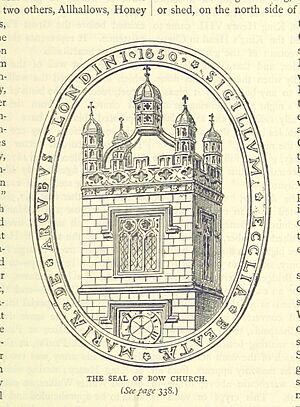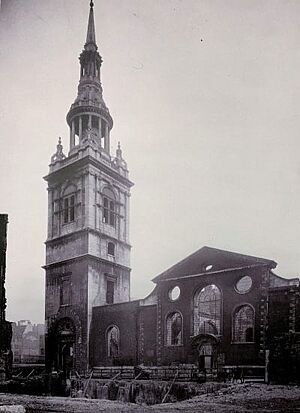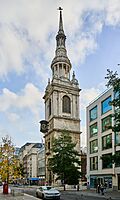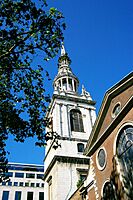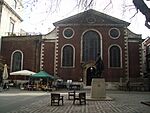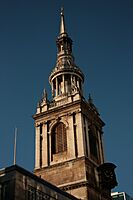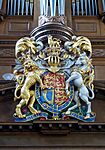St Mary-le-Bow facts for kids
Quick facts for kids St Mary-le-Bow |
|
|---|---|
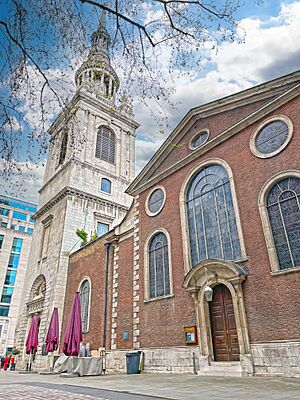
View from Bow Churchyard
|
|
| Lua error in Module:Location_map at line 420: attempt to index field 'wikibase' (a nil value). | |
| Location | Cheapside, City of London, EC2 |
| Denomination | Church of England |
| History | |
| Founded | 1080 |
| Founder(s) | Lanfranc |
| Dedication | Mary, Mother of Jesus |
| Architecture | |
| Architect(s) |
|
| Administration | |
| Benefice | St Mary-le-Bow |
| Deanery | The City |
| Archdeaconry | London |
| Diocese | London |
| Province | Canterbury |
The Church of St Mary-le-Bow is a famous Church of England parish church in the City of London, England. It stands on Cheapside, one of London's oldest streets. The church was first built in 1080 by Lanfranc, who was the Archbishop of Canterbury.
Over the years, the church was rebuilt many times. The building you see today was designed by Sir Christopher Wren after the terrible Great Fire of London in 1666. Its tall spire is a well-known sight in London. It's the third tallest of all the churches Wren designed, only shorter than St Paul's Cathedral and St Bride's. Building it cost over £15,000, making it Wren's second most expensive church after St Paul's.
St Mary-le-Bow is also famous for its bells. They are even mentioned in the nursery rhyme 'Oranges and Lemons'. A legend says that Dick Whittington heard the bells calling him back to London in 1392. This led him to become the Lord Mayor of London. For a long time, people believed that if you were born close enough to hear these bells, you were a true Londoner, also known as a Cockney.
During the Second World War, the church was badly damaged by bombs in an event called the Blitz. The inside was almost completely destroyed, and the bells fell to the ground. But the tower survived! The church was carefully rebuilt between 1956 and 1964. It was given the highest possible protection status, called Grade I listed status, even when it was still a ruin in 1950.
History of the Church
How the Church Started
Long ago, even before the Normans came to England, there might have been an older building on this spot. But the first church we know for sure was built here in 1080. It was dedicated to St Mary and built by Lanfranc, the Archbishop of Canterbury. Lanfranc came from Normandy with William the Conqueror. He built this church as part of a plan to control London. Other big buildings from this time include St Paul's Cathedral and the Tower of London.
The first St Mary's church was built using special Caen stone from Normandy, just like the Tower of London. The architect for the Tower of London, Gundulf, might have also designed this church. This early church had two levels. There was a lower part called an undercroft and an upper church built above it. The lower part had round stone arches, which were very new and exciting at the time. Because of these arches, the church became known as Sancta Maria de Arcubus (St Mary of the Arches). This name eventually became St Mary-le-Bow, where "bow" means arches.
Early Challenges: Storms and Fires
The church was almost finished in 1091 when a very strong tornado hit London. It was one of the most powerful tornadoes ever in England! The roof beams, which were about 27 feet long, were thrown into the air and stuck into the ground. The lower church survived, but the upper church was too damaged to fix. The church was rebuilt, but it was destroyed again in a fire in 1196. This fire started when a man named William Fitz Osbert was hiding in the church tower. People set fire to the church to get him out.
Medieval Times
The church was rebuilt again in the early 1200s. It became a special church for the Archbishops of Canterbury and their main office in London. It was home to the Court of Arches, which was a special court for the church. This court, which still meets at St Mary-le-Bow today, handled appeals for the church in England. Because of its link to the Archbishop of Canterbury, it was the second most important church in London, after St Paul's Cathedral.
In 1271, part of the tower fell down, killing a person on Cheapside. The tower wasn't fixed right away. From 1363, the tower was used to ring the city's curfew bell every evening at 9 pm. You could hear it far away, even in Hackney Marshes.
Fixing the tower took a long time, with work happening in 1448, 1459, and 1479. The tower was finally finished in 1512. It had amazing stone lanterns that lit up the streets below.
The Great Fire of London (1666)
On Sunday, September 2, 1666, a huge fire started in a bakery. The wind quickly spread the fire through the city. It burned down 300 houses on the first night! The fire grew into a massive firestorm and moved towards St Paul's Cathedral.
St Mary-le-Bow was one of over fifty churches that caught fire. The church was almost completely destroyed. Only the tower survived, though it was damaged by the fire. People tried to fix the tower, but it was too weak to hold the heavy bells.
Wren Rebuilds the Church
After the Great Fire, Christopher Wren was hired to rebuild the many churches that were destroyed. St Mary-le-Bow was seen as one of the most important churches in the city, second only to St Paul's Cathedral. So, it was one of the first churches to be rebuilt.
Wren first planned a simpler church with a short tower. But he changed his mind and designed a much taller tower with a fancy spire. The main part of the church was finished by 1673. The tower took seven more years, finally completed in 1680. The total cost was over £15,000, making it Wren's second most expensive church. The tower was built with strong Portland stone, and the rest of the church was made of brick. The tower became so famous that people called it the "Cheapside pillar."
When building the tower's foundations, Wren found an old Roman road about 18 feet underground. This gave him a very strong base for the tower. He also found the 11th-century undercroft (the lower church) but thought it was Roman. He just added a trapdoor and ladder, turning it into the church's crypt.
Later Years and War Damage
In 1820, the top part of the spire was rebuilt. In 1850, the church stopped being a 'peculiar' (a special church not under the usual church rules) and came under the control of the Diocese of London. But it still kept the Court of Arches.
In 1914, a stone from the church's crypt was sent to Trinity Church in New York. This was to remember that an old English king had given Trinity Church the same rights as St Mary-le-Bow.
Second World War Destruction
Starting in 1940, German planes began bombing British cities in what was called the Blitz. London was hit very hard. For most of the Blitz, St Mary-le-Bow only had small damage. But on the last big night of bombing, May 10–11, 1941, the church was hit directly several times. A huge fire started, destroying most of the building except the outer walls and the tower. The tower wasn't hit directly, but the fire spread into it, burning out the floors and causing the famous bells to crash to the ground. The tower survived because it was built with strong Portland stone, unlike the brick used for the rest of the church.
From 1956 to 1964, the church was carefully rebuilt to Wren's original designs. The tower was mostly still there, but some parts needed fixing because of fire damage. The church was officially opened again in 1964. It had already been given Grade I listed status in 1950, even when it was still a ruin.
Church Design
Layout of the Building
The church building is shaped like a rectangle. The tower is on the northwest side, separated from the main church by a small entrance area called a vestibule. The church's design means it is longer from north to south than from east to west. It measures about 79 feet from east to west but 131 feet from the north wall of the tower to the south wall of the church.
Outside the Church
The outside of St Mary-le-Bow is mostly made of red brick with Portland stone details. The tower, however, is built entirely from Portland stone. The church has three main sides (south, north, and east) with pointed walls and arched windows.
The most striking part of the outside is Wren's impressive tower. It is about 30 feet square and stands 221 feet tall. This makes it the third tallest of all the churches Wren designed.
The tower has four main sections, topped by a detailed stone spire. The lowest section has doorways on the north and west sides. These doorways are set back in large stone areas with special rough-looking stone called rustication. The spire above the tower also has four sections. The lowest part is round and has twelve columns. Above this are twelve curved supports called flying buttresses. The very top of the spire is a tall, square point, finished with a ball and a weathervane shaped like a winged dragon.
Inside the Church
The main part of the church, called the nave, has three sections. It is divided by large, round arches. The ceiling above the nave is curved like a tunnel and is decorated with blue and white panels. Light comes in through windows high up on the walls.
The church's windows are very important, especially after the church was rebuilt in 1964. They were designed by John Hayward. The three windows at the east end of the church have rounded tops.
A small entrance area connects the church and the tower. This area has a stone ceiling with a special cross shape. There's a removable trapdoor in the ceiling, which is used to lower or raise the bells from the tower.
Beneath the church is an 11th-century crypt. This crypt was originally the undercroft of the church that was destroyed by the tornado in 1091. It has old Norman-style round arches, some of which even contain Roman bricks. This crypt is now used as a cafe called "Café Below."
Music at St Mary-le-Bow
The Organ
The first record of an organ in the church is from 1802. It was a small organ with 13 stops (different sounds) and 2 manuals (keyboards). This organ was placed above the west doors. In 1867, it was rebuilt and made larger.
In 1880, a new, much bigger organ was built for St Mary-le-Bow. It had 33 stops and 3 manuals. This organ stayed until the Blitz. When the church was hit by bombs, the organ was removed to keep it safe.
After the church was restored in 1964, the organ was changed. It was made smaller, and only 18 of the original 33 stops were put back. A new case was designed and placed above the west door. Many people thought this organ wasn't as good as the old one, but there wasn't enough money to replace it for 40 years.
In 2004, the church started a project to get a new organ. The project cost £380,000 and was paid for by donations. In January 2010, the old organ was taken out. The 1964 case was kept, but new pipes were installed. The new organ was finished in August 2010. It has 34 stops and two manuals.
The church also has a smaller organ with 1 manual and 5 stops. It is in the south part of the church.
The Famous Bells
History of the Bells
The bells at St Mary-le-Bow are often called the most famous bells in the world. The legend of Dick Whittington hearing them call him back to London in 1392 is well-known.
The first written record of bells here is from 1469. The city council ordered that a curfew bell should be rung at St Mary-le-Bow every evening at 9:00. In 1515, a merchant named William Copland gave money for a "great bell" to be added. With Copland's gift, the tower then had five bells.
In 1666, during the Great Fire of London, the bells and tower were badly damaged. After the fire, when Wren rebuilt the church, a new large bell was made in 1669. The other seven bells were made and hung in the new tower in 1677. This made a set of eight bells.
Bells in the 18th and 19th Centuries
Over the years, the bells were recast and rehung several times to improve their sound. In 1762, two more bells were added, making a set of ten. In 1881, two new bells were cast, bringing the total to twelve. This made St Mary-le-Bow one of only five churches in London with a set of twelve bells.
The Selfridge's Bells
By 1927, the bells were in bad shape and couldn't be rung. This made many people sad. In 1933, Harry Gordon Selfridge, who owned the famous Selfridges store, offered to pay to fix the bells.
When the bells were taken down, it was found that five of them were cracked. These five, plus three lighter bells, were recast (melted down and made new). The other four bells were retuned. The bells were put back in their original frame, which was made much stronger with concrete and steel. The Archbishop of Canterbury officially rededicated the bells on July 7, 1933.
Soon after, the BBC World Service recorded the bells to use as a time signal. This made the bells famous around the world! But on the night of May 10, 1941, the church was hit by bombs. Even though the tower wasn't hit directly, the fire from the church spread into it. The tower became like a giant furnace, destroying the inside and causing the bells to crash over 100 feet to the ground. They were completely ruined.
After the War
The damaged bells were taken to a foundry (a place where metal is cast) but stayed in storage for over 10 years. In 1956, when the church restoration began, new bells were cast. Much of the money for this came from the Bernard Sunley Charitable Foundation and Trinity Church in New York City. A new set of twelve bells was made in 1956, using some metal from the old bells. They were finally hung in late 1961.
The bells were officially dedicated by Prince Philip, Duke of Edinburgh on December 21, 1961. Since then, the bells have been rung often by bell ringers from all over the world.
All the bells have names and a special message from the Psalms. The first letter of each bell's name spells out 'D. Whittington'. The largest bell weighs about 4,697 pounds (2,131 kg). It is the third heaviest main bell in London, after St Paul's and Southwark Cathedral.
Bell Details
| Bell
Number |
Name | Weight
(cwt-qrs-lbs) |
Weight
(kg/lbs) |
Note | Diameter
(inches) |
|---|---|---|---|---|---|
| 1 | Katherine | 5-3-21 | 302 kg (666 lb) | G | 27.75 |
| 2 | Fabian | 5-3-10 | 297 kg (655 lb) | F | 29.00 |
| 3 | Christopher | 6-1-7 | 321 kg (708 lb) | E | 30.00 |
| 4 | Margaret | 6-2-17 | 338 kg (745 lb) | D | 32.00 |
| 5 | Mildred | 7-3-27 | 406 kg (895 lb) | C | 34.00 |
| 6 | Faith | 8-3-27 | 457 kg (1,008 lb) | B | 35.00 |
| 7 | Augustine | 10-0-20 | 517 kg (1,140 lb) | A | 38.00 |
| 8 | John | 12-1-11 | 627 kg (1,382 lb) | G | 41.00 |
| 9 | Timothy | 17-3-17 | 909 kg (2,004 lb) | F | 46.00 |
| 10 | Pancras | 21-2-23 | 1,103 kg (2,432 lb) | E | 49.00 |
| 11 | Cuthbert | 29-1-5 | 1,488 kg (3,280 lb) | D | 54.00 |
| 12 | Bow | 41-3-21 | 2,131 kg (4,698 lb) | C | 61.25 |
| All bells have the Whitechapel Bell Foundry mark on them, along with the date they were recast (1956). | |||||
| Sources: | |||||
Services at the Church
St Mary-le-Bow mainly serves people who work in the financial industry and for livery companies in the City of London. Because of this, services are held on weekdays instead of the usual Sunday mornings. There are usually two short prayer services every weekday, one at 8:30 am and another at 5:45 pm. There are also two more formal services, called Eucharist, on Wednesday lunchtimes at 1:05 pm and Thursday evenings at 6:05 pm.
|


